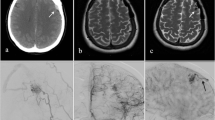Abstract
A 22-year-old male, presented with epilepsy, was treated with upfront (primary); Gamma Knife-based SRS for left, temporal, medium size AVM. The target volume of 7.0 cc received a prescribed dose of 20.0 Gy normalized to 50% isodose line. At 12 months post-SRS, follow-up MRI showed a marked decrease in size of AVM nidus, coupled with perinidal high signal in T2 and FLAIR studies, denoting vasogenic edema. At 18 months post-SRS, follow-up MRI showed non-visualized AVM nidus and appearance of focal encephalomalacia at the site of prior nidus. At last follow-up (24 months post-SRS), conventional cerebral angiography documented complete obliteration of the AVM nidus. The successful radiosurgery treatment was coupled with control of the patient’s seizures with anticonvulsant medications.
Access provided by Autonomous University of Puebla. Download chapter PDF
Similar content being viewed by others
Keywords
- Arteriovenous malformation
- Medium size AVM
- Cerebral AVM
- Seizures
- Stereotactic radiosurgery
- Gamma knife-based SRS
- Primary SRS
- Cerebral angiography
- Perinidal edema
- Nidus obliteration
- Encephalomalacia
-
Demographics: Male; 22 years
-
Initial Presentation: Epilepsy for 1 year before radiosurgery treatment
-
Diagnosis: Medium size brain AVM
-
Pre-radiosurgery Treatment: None
-
Pre-radiosurgery Presentation:
-
Epilepsy (partial seizures with secondary generalization)
-
Dysphasia
-
Headache
-
-
Radiosurgery Treatment:
Upfront (primary); Gamma Knife-based SRS for left, temporal, medium size AVM
-
Radiosurgery Dosimetry:
-
Target volume: 7.0 cc
-
Prescribed dose: 20.0 Gy
-
Isodose line: 50%
-
-
Follow-Up Period: 24 months post-SRS
-
Clinical Outcome:
-
6 months post-SRS:
-
Improving seizures with medications
-
Stationary dysphasia
-
Stationary headache
-
-
12 months post-SRS:
-
Increased frequency of seizures despite medications
-
Worsened dysphasia
-
Worsened headache
-
-
18 months post-SRS:
-
Controlled seizures with medications
-
Improving dysphasia
-
Improving headache
-
-
24 months post-SRS:
-
Sustainable control of seizures with medications
-
Mild residual dysphasia
-
Improved headache
-
-
-
Complications: None
-
Radiological Outcome:
-
12 months post-SRS (MRI):
-
Marked decrease in size of AVM nidus
-
Appearance of focal ring enhancing lesion at the site of AVM nidus, in T1 Gadolinium-enhanced study, denoting radiation necrosis
-
Appearance of perinidal high signal in T2 and FLAIR studies, denoting vasogenic edema
-
-
18 months post-SRS (MRI):
-
Non-visualized AVM nidus
-
Appearance of small focal encephalomalacia at the site of prior AVM nidus
-
Persistence of high signal in T2 and FLAIR studies at the site of prior AVM nidus
-
-
24 months post-SRS (conventional angiography): Complete obliteration of AVM nidus
-
-
Post-radiosurgery Treatment: Continued anticonvulsant medications







Further Reading
Abdelaziz O, Sherin A, Inoue T, et al. Correlation of appearance of MRI perinidal T2 hyperintensity signal and eventual nidus obliteration following photon radiosurgery of brain AVMs: combined results of LINAC and Gamma Knife centers. J Neurol Surg A Cent Eur Neurosurg. 2019;80:187–97.
Kano H, Flickinger JC, Tonetti D, et al. Estimating the risks of adverse radiation effects after Gamma knife radiosurgery for arteriovenous malformations. Stroke. 2017;48:84–90.
Raboud M, Tuleasca C, Maeder P, et al. Gamma knife radiosurgery for arteriovenous malformations: general principles and preliminary results in a Swiss cohort. Swiss Med Wkly. 2018;148:w1460. https://doi.org/10.4414/smw.2018.14602.
Schäuble B, Cascino GD, Pollock BE, et al. Seizure outcomes after stereotactic radiosurgery for cerebral arteriovenous malformations. Neurology. 2004;63(4):683–7.
Yamamoto M, Ide M, Jimbo M, et al. Gamma Knife radiosurgery in medium-sized arteriovenous malformations: preliminary report. Stroke Surg. 1996;24(6):465–73. https://doi.org/10.2335/scs1987.24.6_465.
Author information
Authors and Affiliations
Corresponding author
Rights and permissions
Copyright information
© 2023 The Author(s), under exclusive license to Springer Nature Switzerland AG
About this chapter
Cite this chapter
Abdelaziz, O.S., De Salles, A.A.F. (2023). Medium Size Brain Arteriovenous Malformation (AVM). In: NeuroRadiosurgery: Case Review Atlas. Springer, Cham. https://doi.org/10.1007/978-3-031-16199-5_2
Download citation
DOI: https://doi.org/10.1007/978-3-031-16199-5_2
Published:
Publisher Name: Springer, Cham
Print ISBN: 978-3-031-16198-8
Online ISBN: 978-3-031-16199-5
eBook Packages: MedicineMedicine (R0)



